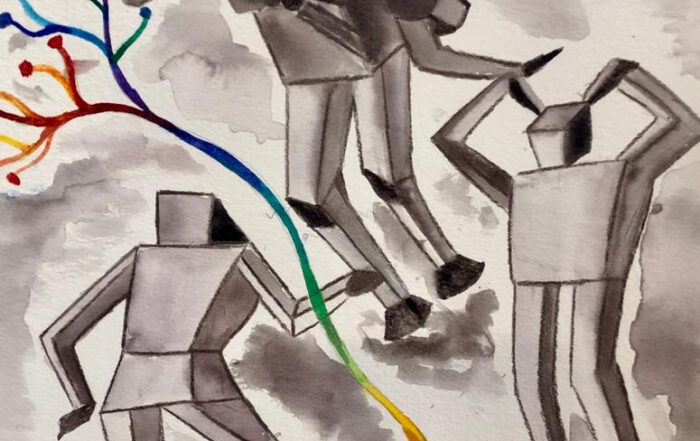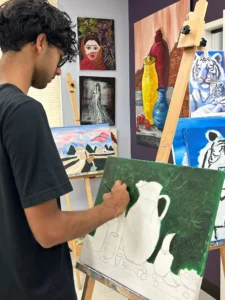Changing Our Wiring

By Saesha Sharda, Sophomore, 27 November 2021 Humanity does not have a lack of struggles, and nowadays chaos is dissociating into different parties, groups, and movements. Sometimes, it is important to take a step back and think about the basic things required to clear the chaos, and that is exactly what my artwork focuses on. I made this artwork for the Reflections Art contest 2021 for which I was awarded Merit of excellence. This art was an abstract representation of my thoughts. I chose watercolors and handmade paper as a medium. In my artwork, there are 4 beings shown in a setting of chaos. There are two beings pictured in the middle arguing, causing a ruckus. Being at the top, however, is productive and carries a friend across the crisis. Also pictured in the artwork is a neuron. The way neurons communicate is by passing on a message from the ends of the neuron, called axons. The arguing beings are not near the axons and therefore are not able to receive the message that is being relayed. Therefore, they are arguing, causing even more spread of confusion and chaos. The beings at the top, however, can receive that knowledge and are able to channel their love and empathy towards helping those who are struggling in the crisis. My artwork shows that the passage out of the crisis is through human compassion and that the ignorance of information does the opposite. Take for example the battle for LGBTQ+ rights around the world. Countless studies have shown that being queer is not a choice and that individuals in the LGBTQ+ community do not deserve to be discriminated against. This aspect represents the logical component. We can also listen to and learn from the experiences of LGBTQ+ individuals and empathize with their struggles. This aspect represents the empathetic component. Bigots who despise individuals of the LGBTQ+ community ignore the information, which leads to assumptions and the spreading of hate. We must clear the chaos by collectively looking at information and empathizing with others; We must change our wiring.
Celebrating Colors with Mother Teresa
By Arjun Anand, Grade 8th Many people have heard of Mother Teresa. She was a nun who helped “the poorest of the poor.” She did so in Calcutta, India, for most of her life. Many admired her for her charitable work. The painting I made honors her, and the services she did in her lifetime. For this painting, I used Cubism as my main technique. Some famous cubist artists are Piet Mondrian and Salvador Dali. Cubism was prominent in the early 20th century, and it was pioneered by Pablo Picasso and Georges Braque. In cubist art, objects are analyzed and broken up and reassembled in an abstracted form. To me, cubism represents the idea that not everything is perfect and that they don’t have to be perfect to look good. In my drawing, I added many different colors to show uniqueness. I also added small details, such as earrings, which reminded me of my mom. To honor Mother Teresa, I drew blue stripes running across the drawing. The stripes represented the blue stripes on Mother Teresa’s sari. A sari is an article of traditional clothing that women wear in India. To do this drawing, I used many tools and techniques. I started off by penciling in the basic lines and shapes. To make my lines for my cubes straight, I used a ruler. Once I was done with that, I used a 0.1 black inking pen to ink the drawing. Now, the basic drawing was done, I just had to color the rest. To do that, I used Copic Brush Markers to color the drawing. I colored each square a different color. In the end, I was happy with the result.










